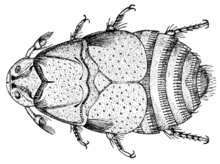Beaver beetle
| Platypsyllus castoris | |
|---|---|
 | |
| Scientific classification | |
| Kingdom: | Animalia |
| Phylum: | Arthropoda |
| Class: | Insecta |
| Order: | Coleoptera |
| Suborder: | Polyphaga |
| Infraorder: | Staphyliniformia |
| Superfamily: | Staphylinoidea |
| Family: | Leiodidae |
| Subfamily: | Platypsyllinae |
| Genus: | Platypsyllus Ritsema, 1869 |
| Species: | P. castoris |
| Binomial name | |
| Platypsyllus castoris Ritsema, 1869[1] | |
The Beaver beetle (Platypsyllus castoris) is an ectoparasitic beetle that only hosts on beavers.[2][3] It is flattened and eyeless,[4] resembling a flea or tick. It used to be placed in a separate family called Leptinidae, but is now placed in the family Leiodidae, in its own subfamily, Platypsyllinae.[1]
Description
The beaver beetle has various modifications to suit its ectoparasitic mode of life. It resembles a flea or a louse in appearance and was originally placed in the flea family Platypsyllidae. It has no wings and no eyes, and its antennal clubs have the antennomeres numbered 3 to 11 shortened, compacted globularly, and partly enclosed in a scoop-shaped antennomere. The larvae are also ectoparasitic on beavers and have hooks on the three thoracic segments which enable it to cling to its host.[1]
Distribution
The beetle exists only in the northern hemisphere (holarctic) and is restricted to areas in which beavers are found, North America and northern Europe and Asia.[1]
Behaviour
Besides the North American beaver (Castor canadensis) and the Eurasian beaver (Castor fiber), the only other host on which this beetle has been found is the North American river otter (Lontra canadensis), and this was only on one occasion. It is hypothesized that the otter may have picked up the parasite when it entered a beaver lodge or perhaps killed a young beaver, a thing that otters are believed to do on occasion. Both adult beetles and larvae feed on epidermal tissue, and also perhaps on skin secretions and liquids oozing from wounds. It is possible that the larvae may also act as scavengers in the beaver lodge.[1]
References
- 1 2 3 4 5 Peck, S. B. (March–June 2006). "Distribution and biology of the ectoparasitic beaver beetle Platypsyllus castoris Ritsema in North America (Coleoptera: Leiodidae: Platypsyllinae)". Insecta Mundi. 20 (1–2): 85. ISSN 0749-6737. Retrieved 8 April 2013.
...and Platypsyllus Ritsema 1869 with one apparently Holarctic species, ectoparasitic on the two species of Castor.
- ↑ Cardé, Vincent H.; Resh, Ring T., eds. (2009). Encyclopedia of Insects (2nd ed.). Amsterdam: Elsevier/Academic Press. p. 197. ISBN 9780080920900.
Platypsyllus castoris beetles of the family Leiodidae are specialists on beavers,...
- ↑ Whitaker, John O. (1996). National Audubon Society Field Guide to Mammals (Revised ed.). New York: Knopf. p. 568. ISBN 0-679-44631-1.
Beavers are hosts to a unique parasite that lives on the exterior of their bodies—a highly specialized beetle that parasitizes only beavers.
- ↑ Goater, Timothy M.; Goater, Cameron P.; Esch, Gerald W. (2013). Parasitism: The Diversity and Ecology of Animal Parasites (2nd ed.). Cambridge University Press. p. 325. ISBN 9780521190282.
All genera [of Coleoptera, which includes Platypsyllus,] are wingless and are eyeless or have reduced eyes, and are markedly dorsoventrally flattened.
- Behrendt, Marc (July–August 2003). "Beaver Beetles" (PDF). Buckeye Trapper. Retrieved 8 April 2013.
External links
- Beaver Beetles by David Moskowitz